Tendering, Estimating & Cost Control: Methods and Procedures
VerifiedAdded on 2021/04/24
|10
|3479
|150
Report
AI Summary
This report comprehensively examines tendering, estimating, and cost control in construction projects. It begins by outlining various approximate estimation methods, including the plinth area method, unit-based method, and cubical contents method, detailing their applications and suitability. The report then delves into the tendering procedure, specifically focusing on the traditional open tendering method, explaining each stage from advertisement to contract award, including pre-tender stages, evaluation, and negotiations. Furthermore, it emphasizes the importance of vetting contractors, providing a step-by-step guide on assessing a contractor's suitability, including evaluating licenses, credentials, equipment, financial status, litigation history, past work, and contingency plans. The report also highlights the significance of workplace health and safety regulations. The report aims to provide a practical guide to ensure fair practices and best value for money.

TENDERING ESTIMATING & COST CONTROL
Name
Date
Name
Date
Paraphrase This Document
Need a fresh take? Get an instant paraphrase of this document with our AI Paraphraser
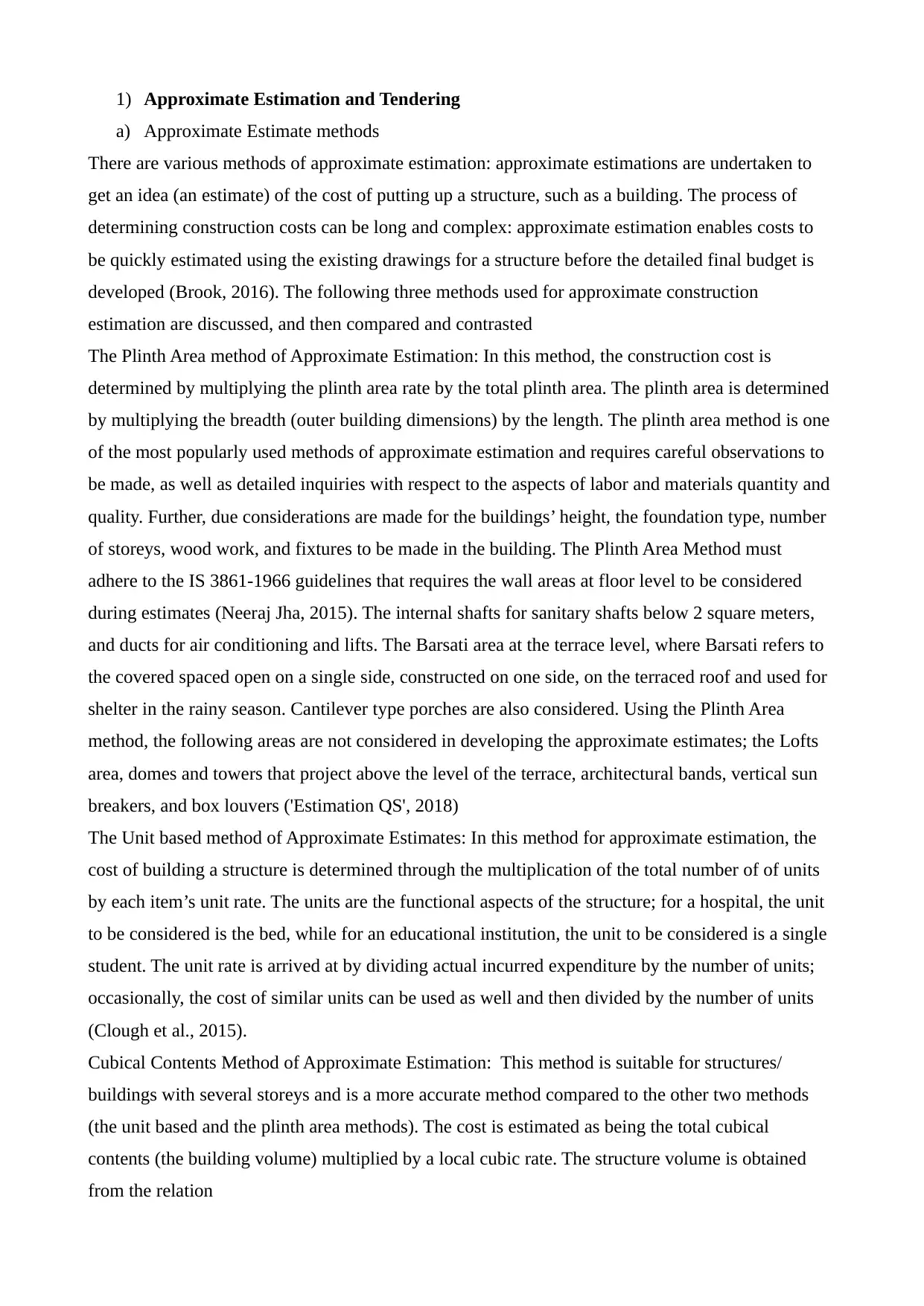
1) Approximate Estimation and Tendering
a) Approximate Estimate methods
There are various methods of approximate estimation: approximate estimations are undertaken to
get an idea (an estimate) of the cost of putting up a structure, such as a building. The process of
determining construction costs can be long and complex: approximate estimation enables costs to
be quickly estimated using the existing drawings for a structure before the detailed final budget is
developed (Brook, 2016). The following three methods used for approximate construction
estimation are discussed, and then compared and contrasted
The Plinth Area method of Approximate Estimation: In this method, the construction cost is
determined by multiplying the plinth area rate by the total plinth area. The plinth area is determined
by multiplying the breadth (outer building dimensions) by the length. The plinth area method is one
of the most popularly used methods of approximate estimation and requires careful observations to
be made, as well as detailed inquiries with respect to the aspects of labor and materials quantity and
quality. Further, due considerations are made for the buildings’ height, the foundation type, number
of storeys, wood work, and fixtures to be made in the building. The Plinth Area Method must
adhere to the IS 3861-1966 guidelines that requires the wall areas at floor level to be considered
during estimates (Neeraj Jha, 2015). The internal shafts for sanitary shafts below 2 square meters,
and ducts for air conditioning and lifts. The Barsati area at the terrace level, where Barsati refers to
the covered spaced open on a single side, constructed on one side, on the terraced roof and used for
shelter in the rainy season. Cantilever type porches are also considered. Using the Plinth Area
method, the following areas are not considered in developing the approximate estimates; the Lofts
area, domes and towers that project above the level of the terrace, architectural bands, vertical sun
breakers, and box louvers ('Estimation QS', 2018)
The Unit based method of Approximate Estimates: In this method for approximate estimation, the
cost of building a structure is determined through the multiplication of the total number of of units
by each item’s unit rate. The units are the functional aspects of the structure; for a hospital, the unit
to be considered is the bed, while for an educational institution, the unit to be considered is a single
student. The unit rate is arrived at by dividing actual incurred expenditure by the number of units;
occasionally, the cost of similar units can be used as well and then divided by the number of units
(Clough et al., 2015).
Cubical Contents Method of Approximate Estimation: This method is suitable for structures/
buildings with several storeys and is a more accurate method compared to the other two methods
(the unit based and the plinth area methods). The cost is estimated as being the total cubical
contents (the building volume) multiplied by a local cubic rate. The structure volume is obtained
from the relation
a) Approximate Estimate methods
There are various methods of approximate estimation: approximate estimations are undertaken to
get an idea (an estimate) of the cost of putting up a structure, such as a building. The process of
determining construction costs can be long and complex: approximate estimation enables costs to
be quickly estimated using the existing drawings for a structure before the detailed final budget is
developed (Brook, 2016). The following three methods used for approximate construction
estimation are discussed, and then compared and contrasted
The Plinth Area method of Approximate Estimation: In this method, the construction cost is
determined by multiplying the plinth area rate by the total plinth area. The plinth area is determined
by multiplying the breadth (outer building dimensions) by the length. The plinth area method is one
of the most popularly used methods of approximate estimation and requires careful observations to
be made, as well as detailed inquiries with respect to the aspects of labor and materials quantity and
quality. Further, due considerations are made for the buildings’ height, the foundation type, number
of storeys, wood work, and fixtures to be made in the building. The Plinth Area Method must
adhere to the IS 3861-1966 guidelines that requires the wall areas at floor level to be considered
during estimates (Neeraj Jha, 2015). The internal shafts for sanitary shafts below 2 square meters,
and ducts for air conditioning and lifts. The Barsati area at the terrace level, where Barsati refers to
the covered spaced open on a single side, constructed on one side, on the terraced roof and used for
shelter in the rainy season. Cantilever type porches are also considered. Using the Plinth Area
method, the following areas are not considered in developing the approximate estimates; the Lofts
area, domes and towers that project above the level of the terrace, architectural bands, vertical sun
breakers, and box louvers ('Estimation QS', 2018)
The Unit based method of Approximate Estimates: In this method for approximate estimation, the
cost of building a structure is determined through the multiplication of the total number of of units
by each item’s unit rate. The units are the functional aspects of the structure; for a hospital, the unit
to be considered is the bed, while for an educational institution, the unit to be considered is a single
student. The unit rate is arrived at by dividing actual incurred expenditure by the number of units;
occasionally, the cost of similar units can be used as well and then divided by the number of units
(Clough et al., 2015).
Cubical Contents Method of Approximate Estimation: This method is suitable for structures/
buildings with several storeys and is a more accurate method compared to the other two methods
(the unit based and the plinth area methods). The cost is estimated as being the total cubical
contents (the building volume) multiplied by a local cubic rate. The structure volume is obtained
from the relation
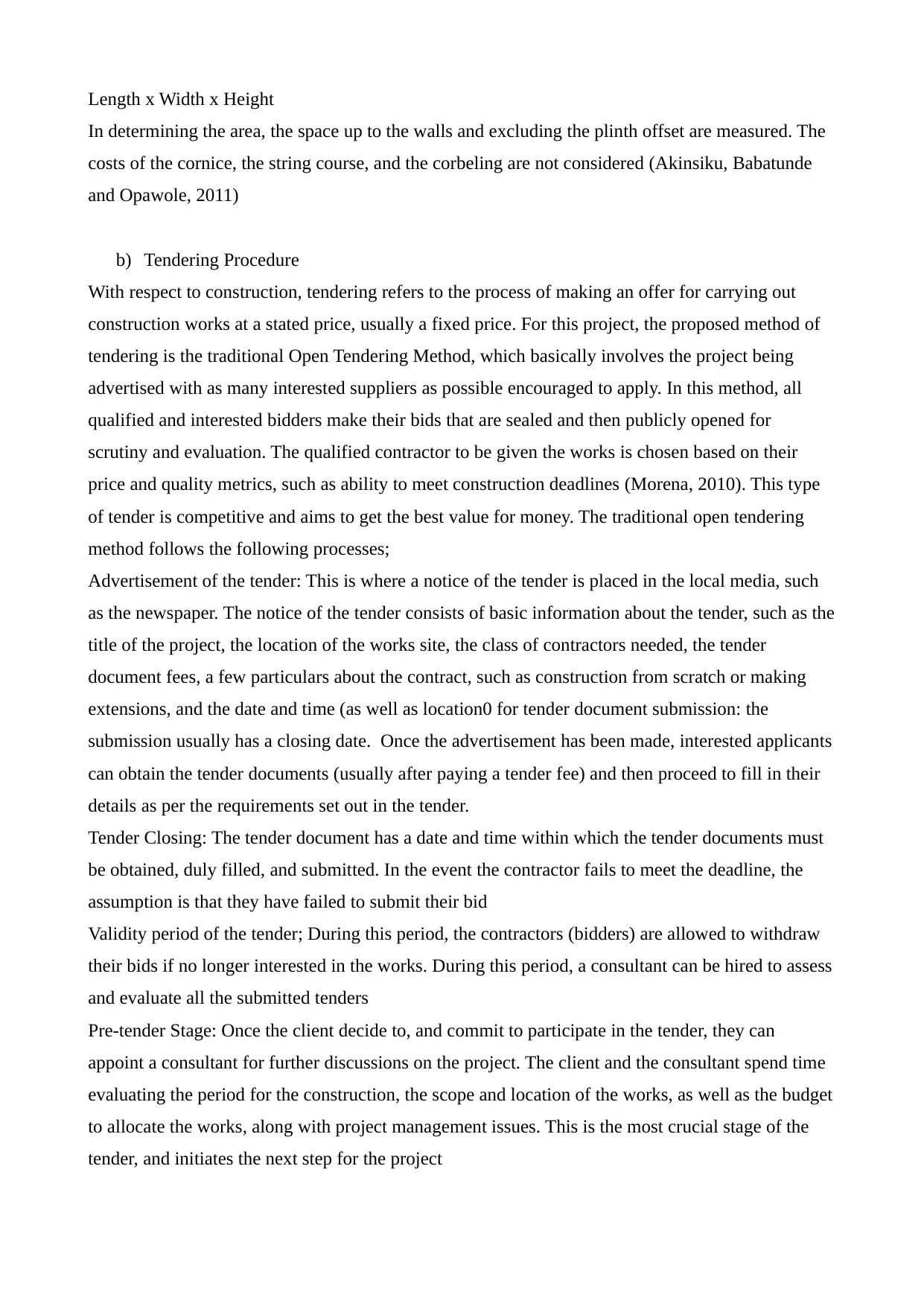
Length x Width x Height
In determining the area, the space up to the walls and excluding the plinth offset are measured. The
costs of the cornice, the string course, and the corbeling are not considered (Akinsiku, Babatunde
and Opawole, 2011)
b) Tendering Procedure
With respect to construction, tendering refers to the process of making an offer for carrying out
construction works at a stated price, usually a fixed price. For this project, the proposed method of
tendering is the traditional Open Tendering Method, which basically involves the project being
advertised with as many interested suppliers as possible encouraged to apply. In this method, all
qualified and interested bidders make their bids that are sealed and then publicly opened for
scrutiny and evaluation. The qualified contractor to be given the works is chosen based on their
price and quality metrics, such as ability to meet construction deadlines (Morena, 2010). This type
of tender is competitive and aims to get the best value for money. The traditional open tendering
method follows the following processes;
Advertisement of the tender: This is where a notice of the tender is placed in the local media, such
as the newspaper. The notice of the tender consists of basic information about the tender, such as the
title of the project, the location of the works site, the class of contractors needed, the tender
document fees, a few particulars about the contract, such as construction from scratch or making
extensions, and the date and time (as well as location0 for tender document submission: the
submission usually has a closing date. Once the advertisement has been made, interested applicants
can obtain the tender documents (usually after paying a tender fee) and then proceed to fill in their
details as per the requirements set out in the tender.
Tender Closing: The tender document has a date and time within which the tender documents must
be obtained, duly filled, and submitted. In the event the contractor fails to meet the deadline, the
assumption is that they have failed to submit their bid
Validity period of the tender; During this period, the contractors (bidders) are allowed to withdraw
their bids if no longer interested in the works. During this period, a consultant can be hired to assess
and evaluate all the submitted tenders
Pre-tender Stage: Once the client decide to, and commit to participate in the tender, they can
appoint a consultant for further discussions on the project. The client and the consultant spend time
evaluating the period for the construction, the scope and location of the works, as well as the budget
to allocate the works, along with project management issues. This is the most crucial stage of the
tender, and initiates the next step for the project
In determining the area, the space up to the walls and excluding the plinth offset are measured. The
costs of the cornice, the string course, and the corbeling are not considered (Akinsiku, Babatunde
and Opawole, 2011)
b) Tendering Procedure
With respect to construction, tendering refers to the process of making an offer for carrying out
construction works at a stated price, usually a fixed price. For this project, the proposed method of
tendering is the traditional Open Tendering Method, which basically involves the project being
advertised with as many interested suppliers as possible encouraged to apply. In this method, all
qualified and interested bidders make their bids that are sealed and then publicly opened for
scrutiny and evaluation. The qualified contractor to be given the works is chosen based on their
price and quality metrics, such as ability to meet construction deadlines (Morena, 2010). This type
of tender is competitive and aims to get the best value for money. The traditional open tendering
method follows the following processes;
Advertisement of the tender: This is where a notice of the tender is placed in the local media, such
as the newspaper. The notice of the tender consists of basic information about the tender, such as the
title of the project, the location of the works site, the class of contractors needed, the tender
document fees, a few particulars about the contract, such as construction from scratch or making
extensions, and the date and time (as well as location0 for tender document submission: the
submission usually has a closing date. Once the advertisement has been made, interested applicants
can obtain the tender documents (usually after paying a tender fee) and then proceed to fill in their
details as per the requirements set out in the tender.
Tender Closing: The tender document has a date and time within which the tender documents must
be obtained, duly filled, and submitted. In the event the contractor fails to meet the deadline, the
assumption is that they have failed to submit their bid
Validity period of the tender; During this period, the contractors (bidders) are allowed to withdraw
their bids if no longer interested in the works. During this period, a consultant can be hired to assess
and evaluate all the submitted tenders
Pre-tender Stage: Once the client decide to, and commit to participate in the tender, they can
appoint a consultant for further discussions on the project. The client and the consultant spend time
evaluating the period for the construction, the scope and location of the works, as well as the budget
to allocate the works, along with project management issues. This is the most crucial stage of the
tender, and initiates the next step for the project
⊘ This is a preview!⊘
Do you want full access?
Subscribe today to unlock all pages.

Trusted by 1+ million students worldwide
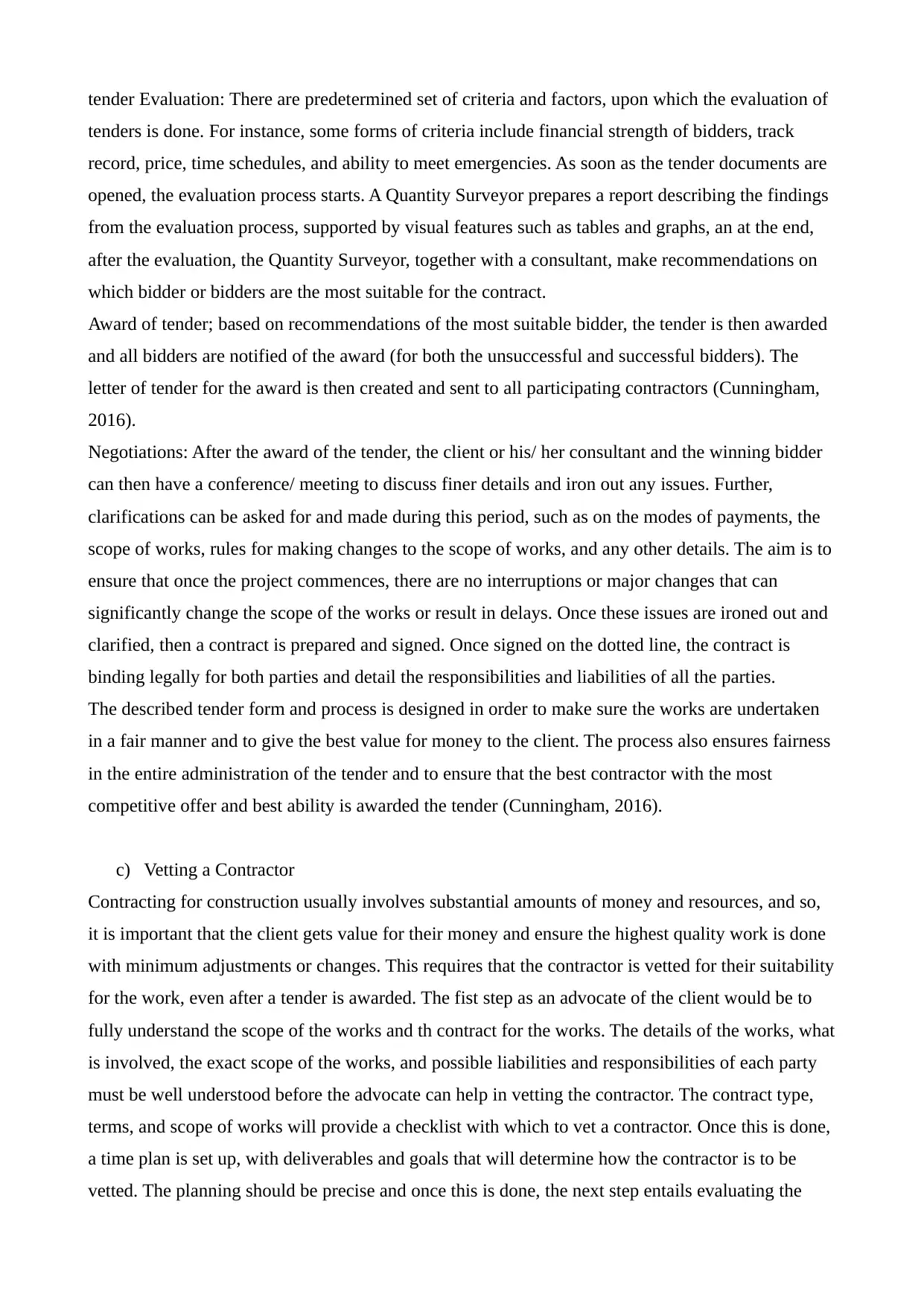
tender Evaluation: There are predetermined set of criteria and factors, upon which the evaluation of
tenders is done. For instance, some forms of criteria include financial strength of bidders, track
record, price, time schedules, and ability to meet emergencies. As soon as the tender documents are
opened, the evaluation process starts. A Quantity Surveyor prepares a report describing the findings
from the evaluation process, supported by visual features such as tables and graphs, an at the end,
after the evaluation, the Quantity Surveyor, together with a consultant, make recommendations on
which bidder or bidders are the most suitable for the contract.
Award of tender; based on recommendations of the most suitable bidder, the tender is then awarded
and all bidders are notified of the award (for both the unsuccessful and successful bidders). The
letter of tender for the award is then created and sent to all participating contractors (Cunningham,
2016).
Negotiations: After the award of the tender, the client or his/ her consultant and the winning bidder
can then have a conference/ meeting to discuss finer details and iron out any issues. Further,
clarifications can be asked for and made during this period, such as on the modes of payments, the
scope of works, rules for making changes to the scope of works, and any other details. The aim is to
ensure that once the project commences, there are no interruptions or major changes that can
significantly change the scope of the works or result in delays. Once these issues are ironed out and
clarified, then a contract is prepared and signed. Once signed on the dotted line, the contract is
binding legally for both parties and detail the responsibilities and liabilities of all the parties.
The described tender form and process is designed in order to make sure the works are undertaken
in a fair manner and to give the best value for money to the client. The process also ensures fairness
in the entire administration of the tender and to ensure that the best contractor with the most
competitive offer and best ability is awarded the tender (Cunningham, 2016).
c) Vetting a Contractor
Contracting for construction usually involves substantial amounts of money and resources, and so,
it is important that the client gets value for their money and ensure the highest quality work is done
with minimum adjustments or changes. This requires that the contractor is vetted for their suitability
for the work, even after a tender is awarded. The fist step as an advocate of the client would be to
fully understand the scope of the works and th contract for the works. The details of the works, what
is involved, the exact scope of the works, and possible liabilities and responsibilities of each party
must be well understood before the advocate can help in vetting the contractor. The contract type,
terms, and scope of works will provide a checklist with which to vet a contractor. Once this is done,
a time plan is set up, with deliverables and goals that will determine how the contractor is to be
vetted. The planning should be precise and once this is done, the next step entails evaluating the
tenders is done. For instance, some forms of criteria include financial strength of bidders, track
record, price, time schedules, and ability to meet emergencies. As soon as the tender documents are
opened, the evaluation process starts. A Quantity Surveyor prepares a report describing the findings
from the evaluation process, supported by visual features such as tables and graphs, an at the end,
after the evaluation, the Quantity Surveyor, together with a consultant, make recommendations on
which bidder or bidders are the most suitable for the contract.
Award of tender; based on recommendations of the most suitable bidder, the tender is then awarded
and all bidders are notified of the award (for both the unsuccessful and successful bidders). The
letter of tender for the award is then created and sent to all participating contractors (Cunningham,
2016).
Negotiations: After the award of the tender, the client or his/ her consultant and the winning bidder
can then have a conference/ meeting to discuss finer details and iron out any issues. Further,
clarifications can be asked for and made during this period, such as on the modes of payments, the
scope of works, rules for making changes to the scope of works, and any other details. The aim is to
ensure that once the project commences, there are no interruptions or major changes that can
significantly change the scope of the works or result in delays. Once these issues are ironed out and
clarified, then a contract is prepared and signed. Once signed on the dotted line, the contract is
binding legally for both parties and detail the responsibilities and liabilities of all the parties.
The described tender form and process is designed in order to make sure the works are undertaken
in a fair manner and to give the best value for money to the client. The process also ensures fairness
in the entire administration of the tender and to ensure that the best contractor with the most
competitive offer and best ability is awarded the tender (Cunningham, 2016).
c) Vetting a Contractor
Contracting for construction usually involves substantial amounts of money and resources, and so,
it is important that the client gets value for their money and ensure the highest quality work is done
with minimum adjustments or changes. This requires that the contractor is vetted for their suitability
for the work, even after a tender is awarded. The fist step as an advocate of the client would be to
fully understand the scope of the works and th contract for the works. The details of the works, what
is involved, the exact scope of the works, and possible liabilities and responsibilities of each party
must be well understood before the advocate can help in vetting the contractor. The contract type,
terms, and scope of works will provide a checklist with which to vet a contractor. Once this is done,
a time plan is set up, with deliverables and goals that will determine how the contractor is to be
vetted. The planning should be precise and once this is done, the next step entails evaluating the
Paraphrase This Document
Need a fresh take? Get an instant paraphrase of this document with our AI Paraphraser
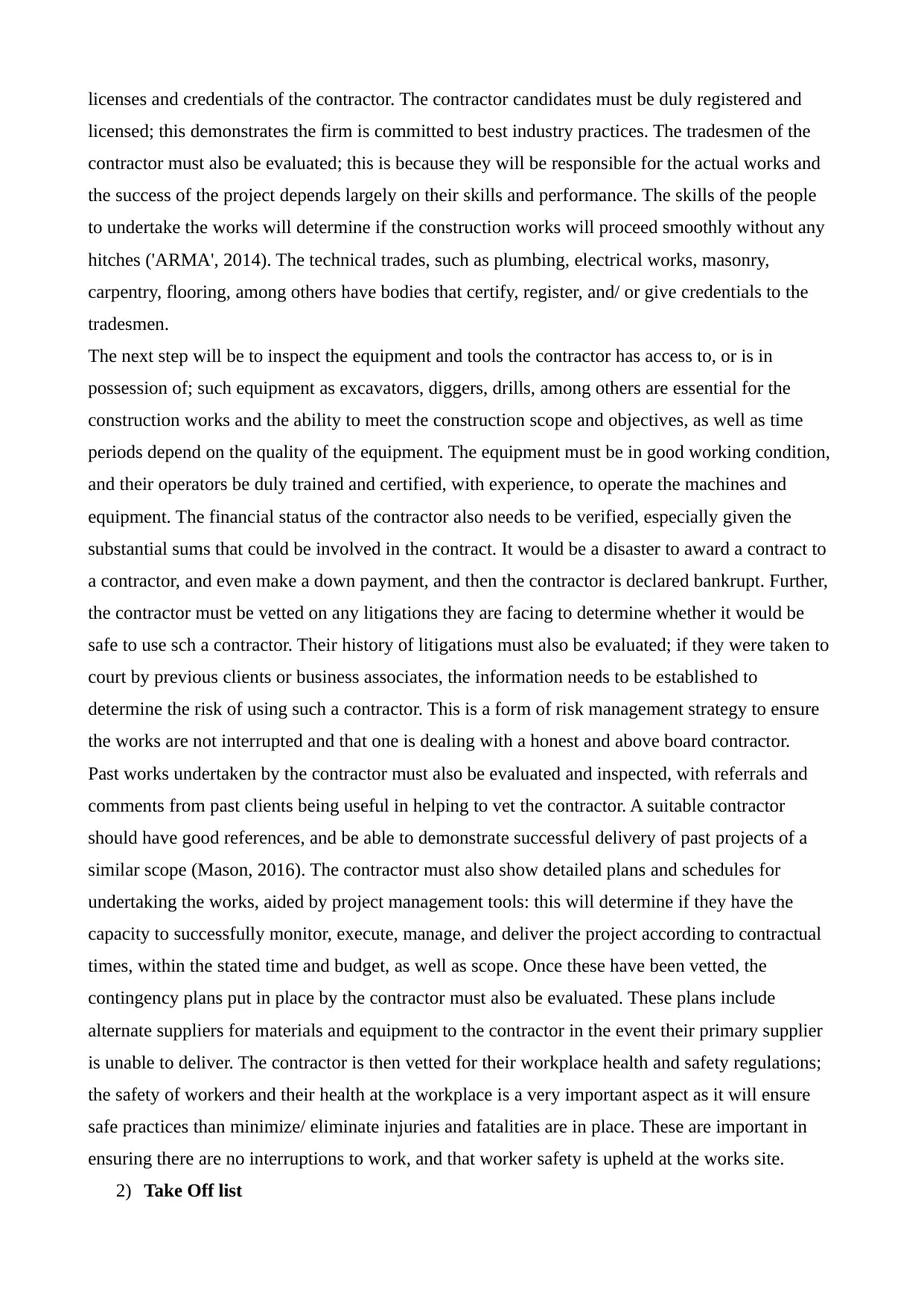
licenses and credentials of the contractor. The contractor candidates must be duly registered and
licensed; this demonstrates the firm is committed to best industry practices. The tradesmen of the
contractor must also be evaluated; this is because they will be responsible for the actual works and
the success of the project depends largely on their skills and performance. The skills of the people
to undertake the works will determine if the construction works will proceed smoothly without any
hitches ('ARMA', 2014). The technical trades, such as plumbing, electrical works, masonry,
carpentry, flooring, among others have bodies that certify, register, and/ or give credentials to the
tradesmen.
The next step will be to inspect the equipment and tools the contractor has access to, or is in
possession of; such equipment as excavators, diggers, drills, among others are essential for the
construction works and the ability to meet the construction scope and objectives, as well as time
periods depend on the quality of the equipment. The equipment must be in good working condition,
and their operators be duly trained and certified, with experience, to operate the machines and
equipment. The financial status of the contractor also needs to be verified, especially given the
substantial sums that could be involved in the contract. It would be a disaster to award a contract to
a contractor, and even make a down payment, and then the contractor is declared bankrupt. Further,
the contractor must be vetted on any litigations they are facing to determine whether it would be
safe to use sch a contractor. Their history of litigations must also be evaluated; if they were taken to
court by previous clients or business associates, the information needs to be established to
determine the risk of using such a contractor. This is a form of risk management strategy to ensure
the works are not interrupted and that one is dealing with a honest and above board contractor.
Past works undertaken by the contractor must also be evaluated and inspected, with referrals and
comments from past clients being useful in helping to vet the contractor. A suitable contractor
should have good references, and be able to demonstrate successful delivery of past projects of a
similar scope (Mason, 2016). The contractor must also show detailed plans and schedules for
undertaking the works, aided by project management tools: this will determine if they have the
capacity to successfully monitor, execute, manage, and deliver the project according to contractual
times, within the stated time and budget, as well as scope. Once these have been vetted, the
contingency plans put in place by the contractor must also be evaluated. These plans include
alternate suppliers for materials and equipment to the contractor in the event their primary supplier
is unable to deliver. The contractor is then vetted for their workplace health and safety regulations;
the safety of workers and their health at the workplace is a very important aspect as it will ensure
safe practices than minimize/ eliminate injuries and fatalities are in place. These are important in
ensuring there are no interruptions to work, and that worker safety is upheld at the works site.
2) Take Off list
licensed; this demonstrates the firm is committed to best industry practices. The tradesmen of the
contractor must also be evaluated; this is because they will be responsible for the actual works and
the success of the project depends largely on their skills and performance. The skills of the people
to undertake the works will determine if the construction works will proceed smoothly without any
hitches ('ARMA', 2014). The technical trades, such as plumbing, electrical works, masonry,
carpentry, flooring, among others have bodies that certify, register, and/ or give credentials to the
tradesmen.
The next step will be to inspect the equipment and tools the contractor has access to, or is in
possession of; such equipment as excavators, diggers, drills, among others are essential for the
construction works and the ability to meet the construction scope and objectives, as well as time
periods depend on the quality of the equipment. The equipment must be in good working condition,
and their operators be duly trained and certified, with experience, to operate the machines and
equipment. The financial status of the contractor also needs to be verified, especially given the
substantial sums that could be involved in the contract. It would be a disaster to award a contract to
a contractor, and even make a down payment, and then the contractor is declared bankrupt. Further,
the contractor must be vetted on any litigations they are facing to determine whether it would be
safe to use sch a contractor. Their history of litigations must also be evaluated; if they were taken to
court by previous clients or business associates, the information needs to be established to
determine the risk of using such a contractor. This is a form of risk management strategy to ensure
the works are not interrupted and that one is dealing with a honest and above board contractor.
Past works undertaken by the contractor must also be evaluated and inspected, with referrals and
comments from past clients being useful in helping to vet the contractor. A suitable contractor
should have good references, and be able to demonstrate successful delivery of past projects of a
similar scope (Mason, 2016). The contractor must also show detailed plans and schedules for
undertaking the works, aided by project management tools: this will determine if they have the
capacity to successfully monitor, execute, manage, and deliver the project according to contractual
times, within the stated time and budget, as well as scope. Once these have been vetted, the
contingency plans put in place by the contractor must also be evaluated. These plans include
alternate suppliers for materials and equipment to the contractor in the event their primary supplier
is unable to deliver. The contractor is then vetted for their workplace health and safety regulations;
the safety of workers and their health at the workplace is a very important aspect as it will ensure
safe practices than minimize/ eliminate injuries and fatalities are in place. These are important in
ensuring there are no interruptions to work, and that worker safety is upheld at the works site.
2) Take Off list
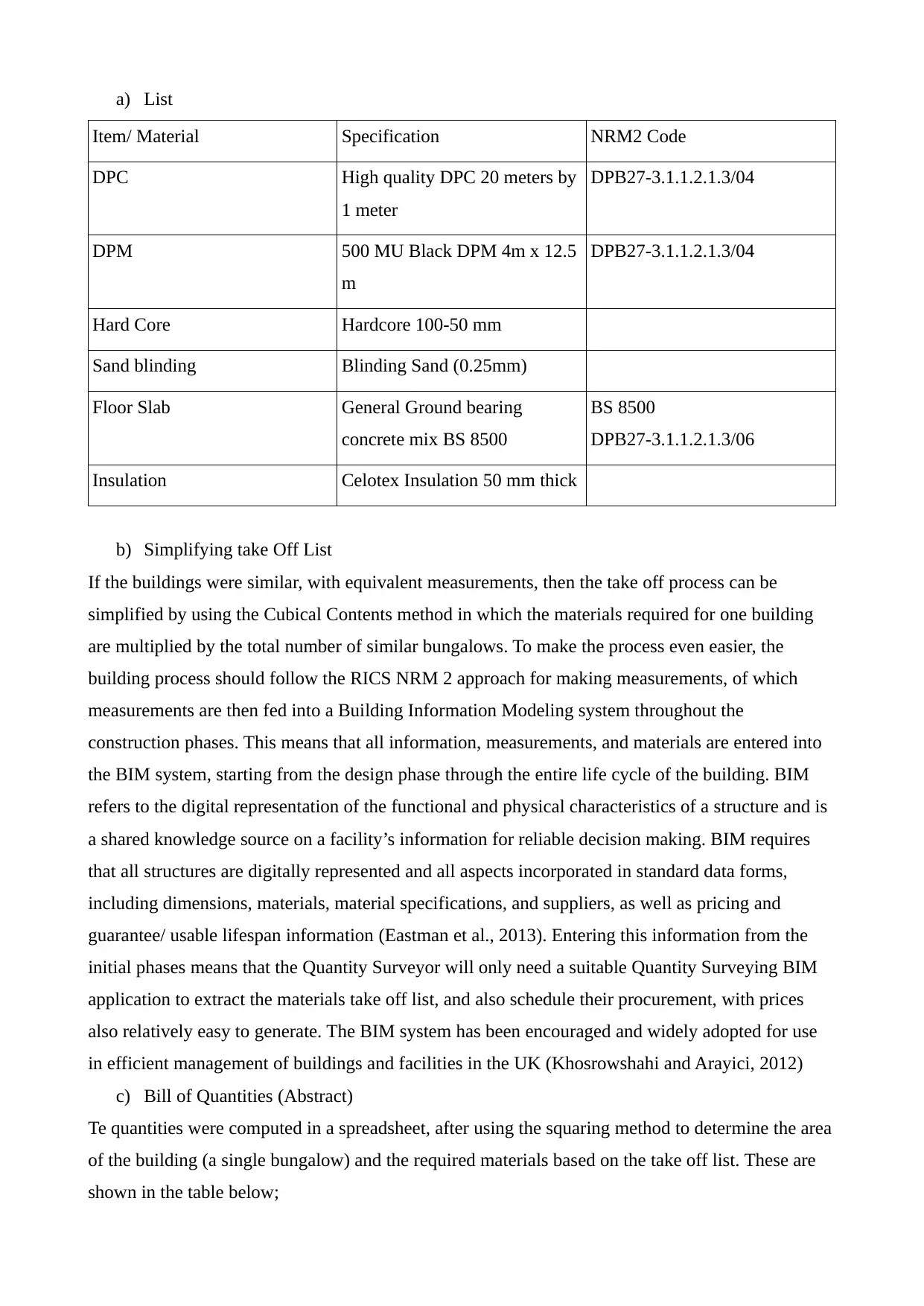
a) List
Item/ Material Specification NRM2 Code
DPC High quality DPC 20 meters by
1 meter
DPB27-3.1.1.2.1.3/04
DPM 500 MU Black DPM 4m x 12.5
m
DPB27-3.1.1.2.1.3/04
Hard Core Hardcore 100-50 mm
Sand blinding Blinding Sand (0.25mm)
Floor Slab General Ground bearing
concrete mix BS 8500
BS 8500
DPB27-3.1.1.2.1.3/06
Insulation Celotex Insulation 50 mm thick
b) Simplifying take Off List
If the buildings were similar, with equivalent measurements, then the take off process can be
simplified by using the Cubical Contents method in which the materials required for one building
are multiplied by the total number of similar bungalows. To make the process even easier, the
building process should follow the RICS NRM 2 approach for making measurements, of which
measurements are then fed into a Building Information Modeling system throughout the
construction phases. This means that all information, measurements, and materials are entered into
the BIM system, starting from the design phase through the entire life cycle of the building. BIM
refers to the digital representation of the functional and physical characteristics of a structure and is
a shared knowledge source on a facility’s information for reliable decision making. BIM requires
that all structures are digitally represented and all aspects incorporated in standard data forms,
including dimensions, materials, material specifications, and suppliers, as well as pricing and
guarantee/ usable lifespan information (Eastman et al., 2013). Entering this information from the
initial phases means that the Quantity Surveyor will only need a suitable Quantity Surveying BIM
application to extract the materials take off list, and also schedule their procurement, with prices
also relatively easy to generate. The BIM system has been encouraged and widely adopted for use
in efficient management of buildings and facilities in the UK (Khosrowshahi and Arayici, 2012)
c) Bill of Quantities (Abstract)
Te quantities were computed in a spreadsheet, after using the squaring method to determine the area
of the building (a single bungalow) and the required materials based on the take off list. These are
shown in the table below;
Item/ Material Specification NRM2 Code
DPC High quality DPC 20 meters by
1 meter
DPB27-3.1.1.2.1.3/04
DPM 500 MU Black DPM 4m x 12.5
m
DPB27-3.1.1.2.1.3/04
Hard Core Hardcore 100-50 mm
Sand blinding Blinding Sand (0.25mm)
Floor Slab General Ground bearing
concrete mix BS 8500
BS 8500
DPB27-3.1.1.2.1.3/06
Insulation Celotex Insulation 50 mm thick
b) Simplifying take Off List
If the buildings were similar, with equivalent measurements, then the take off process can be
simplified by using the Cubical Contents method in which the materials required for one building
are multiplied by the total number of similar bungalows. To make the process even easier, the
building process should follow the RICS NRM 2 approach for making measurements, of which
measurements are then fed into a Building Information Modeling system throughout the
construction phases. This means that all information, measurements, and materials are entered into
the BIM system, starting from the design phase through the entire life cycle of the building. BIM
refers to the digital representation of the functional and physical characteristics of a structure and is
a shared knowledge source on a facility’s information for reliable decision making. BIM requires
that all structures are digitally represented and all aspects incorporated in standard data forms,
including dimensions, materials, material specifications, and suppliers, as well as pricing and
guarantee/ usable lifespan information (Eastman et al., 2013). Entering this information from the
initial phases means that the Quantity Surveyor will only need a suitable Quantity Surveying BIM
application to extract the materials take off list, and also schedule their procurement, with prices
also relatively easy to generate. The BIM system has been encouraged and widely adopted for use
in efficient management of buildings and facilities in the UK (Khosrowshahi and Arayici, 2012)
c) Bill of Quantities (Abstract)
Te quantities were computed in a spreadsheet, after using the squaring method to determine the area
of the building (a single bungalow) and the required materials based on the take off list. These are
shown in the table below;
⊘ This is a preview!⊘
Do you want full access?
Subscribe today to unlock all pages.

Trusted by 1+ million students worldwide
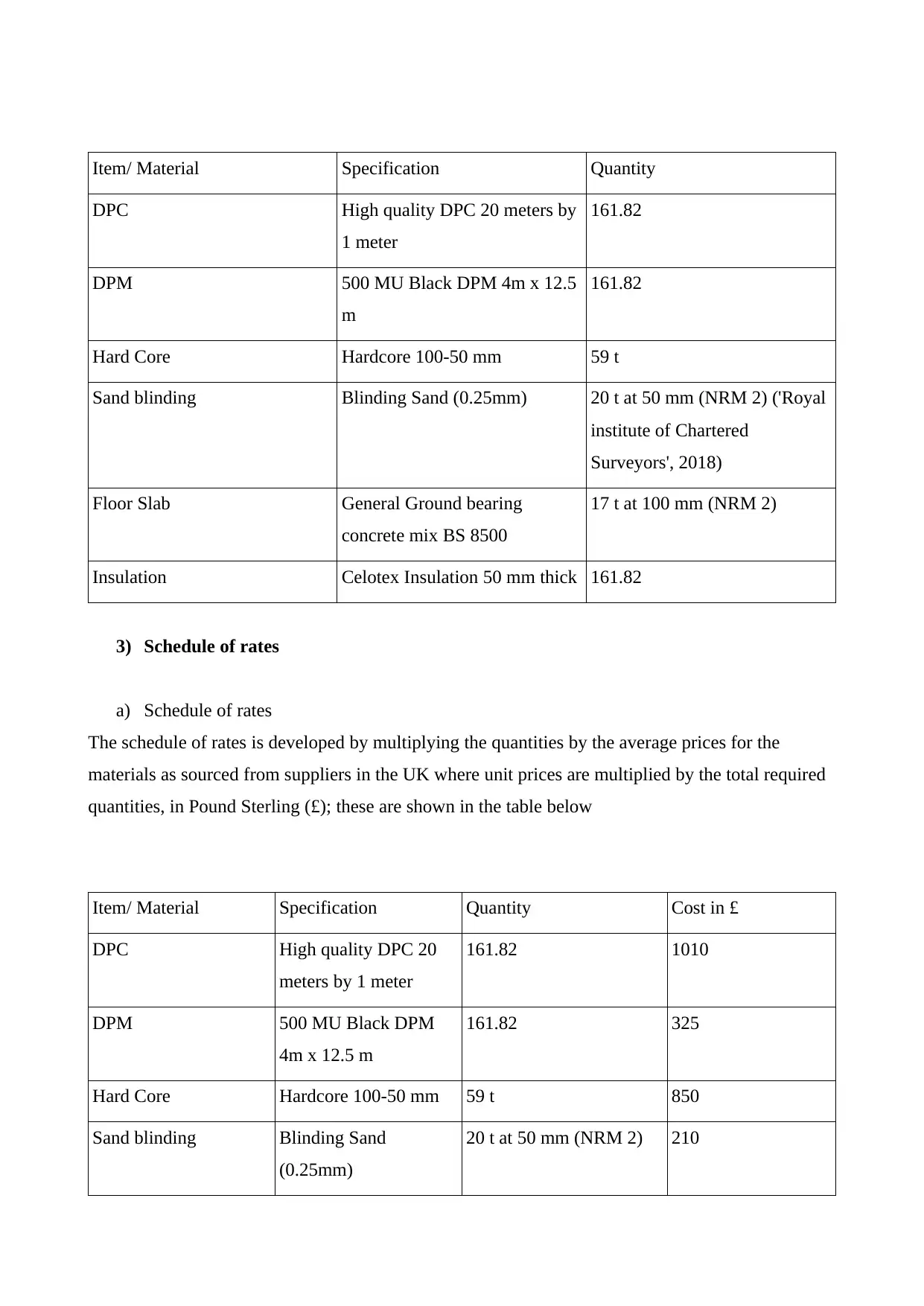
Item/ Material Specification Quantity
DPC High quality DPC 20 meters by
1 meter
161.82
DPM 500 MU Black DPM 4m x 12.5
m
161.82
Hard Core Hardcore 100-50 mm 59 t
Sand blinding Blinding Sand (0.25mm) 20 t at 50 mm (NRM 2) ('Royal
institute of Chartered
Surveyors', 2018)
Floor Slab General Ground bearing
concrete mix BS 8500
17 t at 100 mm (NRM 2)
Insulation Celotex Insulation 50 mm thick 161.82
3) Schedule of rates
a) Schedule of rates
The schedule of rates is developed by multiplying the quantities by the average prices for the
materials as sourced from suppliers in the UK where unit prices are multiplied by the total required
quantities, in Pound Sterling (£); these are shown in the table below
Item/ Material Specification Quantity Cost in £
DPC High quality DPC 20
meters by 1 meter
161.82 1010
DPM 500 MU Black DPM
4m x 12.5 m
161.82 325
Hard Core Hardcore 100-50 mm 59 t 850
Sand blinding Blinding Sand
(0.25mm)
20 t at 50 mm (NRM 2) 210
DPC High quality DPC 20 meters by
1 meter
161.82
DPM 500 MU Black DPM 4m x 12.5
m
161.82
Hard Core Hardcore 100-50 mm 59 t
Sand blinding Blinding Sand (0.25mm) 20 t at 50 mm (NRM 2) ('Royal
institute of Chartered
Surveyors', 2018)
Floor Slab General Ground bearing
concrete mix BS 8500
17 t at 100 mm (NRM 2)
Insulation Celotex Insulation 50 mm thick 161.82
3) Schedule of rates
a) Schedule of rates
The schedule of rates is developed by multiplying the quantities by the average prices for the
materials as sourced from suppliers in the UK where unit prices are multiplied by the total required
quantities, in Pound Sterling (£); these are shown in the table below
Item/ Material Specification Quantity Cost in £
DPC High quality DPC 20
meters by 1 meter
161.82 1010
DPM 500 MU Black DPM
4m x 12.5 m
161.82 325
Hard Core Hardcore 100-50 mm 59 t 850
Sand blinding Blinding Sand
(0.25mm)
20 t at 50 mm (NRM 2) 210
Paraphrase This Document
Need a fresh take? Get an instant paraphrase of this document with our AI Paraphraser
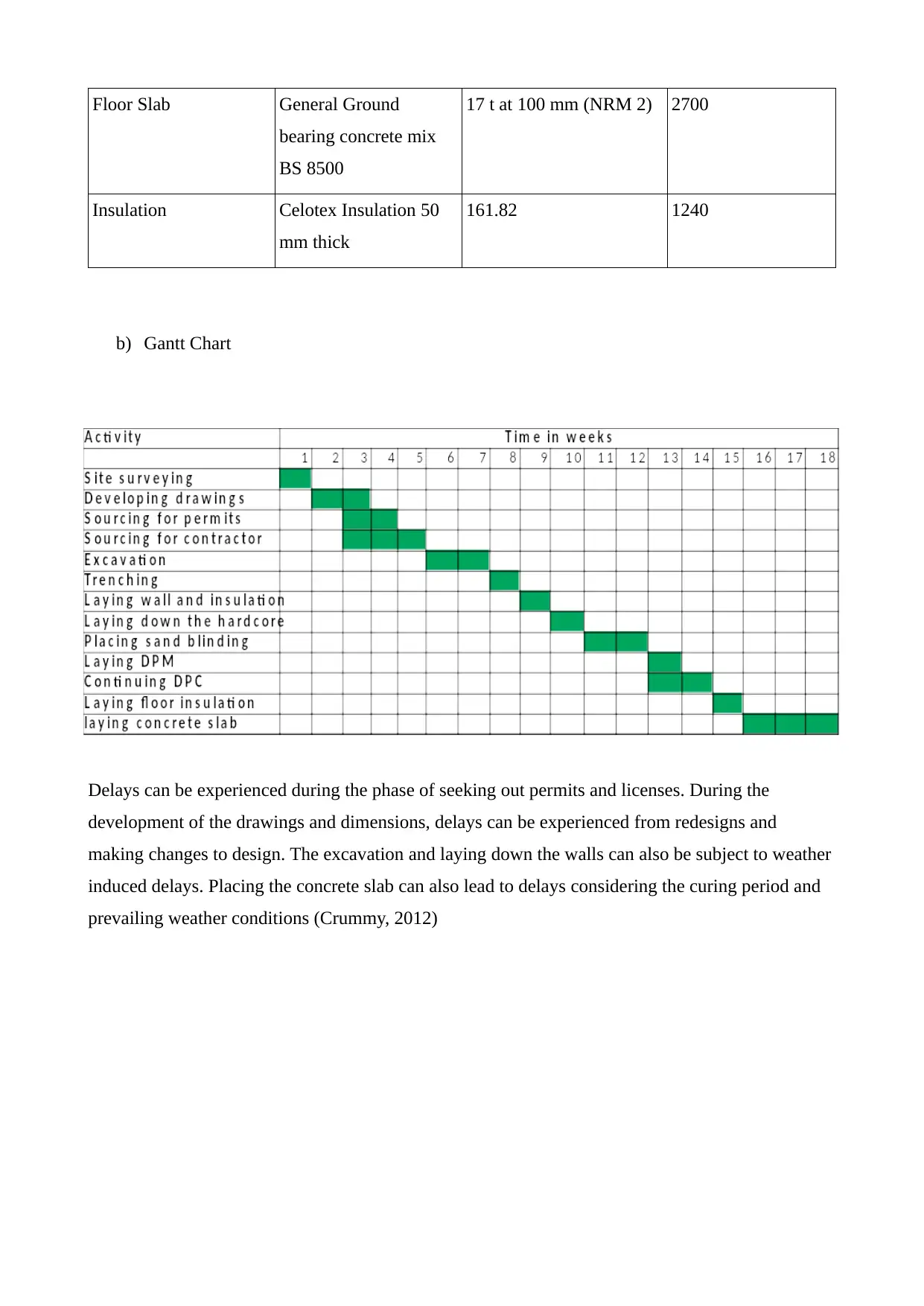
Floor Slab General Ground
bearing concrete mix
BS 8500
17 t at 100 mm (NRM 2) 2700
Insulation Celotex Insulation 50
mm thick
161.82 1240
b) Gantt Chart
Delays can be experienced during the phase of seeking out permits and licenses. During the
development of the drawings and dimensions, delays can be experienced from redesigns and
making changes to design. The excavation and laying down the walls can also be subject to weather
induced delays. Placing the concrete slab can also lead to delays considering the curing period and
prevailing weather conditions (Crummy, 2012)
bearing concrete mix
BS 8500
17 t at 100 mm (NRM 2) 2700
Insulation Celotex Insulation 50
mm thick
161.82 1240
b) Gantt Chart
Delays can be experienced during the phase of seeking out permits and licenses. During the
development of the drawings and dimensions, delays can be experienced from redesigns and
making changes to design. The excavation and laying down the walls can also be subject to weather
induced delays. Placing the concrete slab can also lead to delays considering the curing period and
prevailing weather conditions (Crummy, 2012)
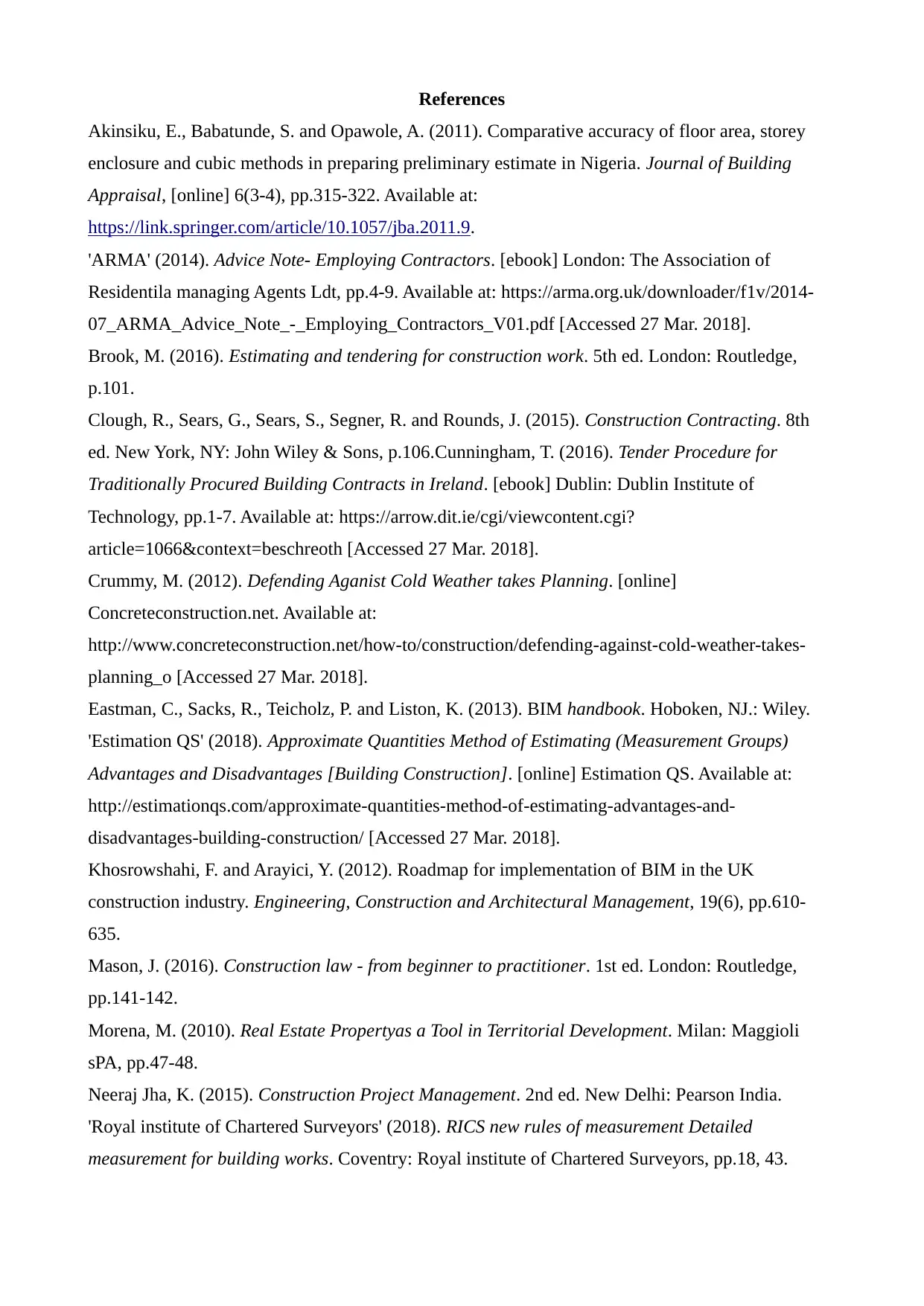
References
Akinsiku, E., Babatunde, S. and Opawole, A. (2011). Comparative accuracy of floor area, storey
enclosure and cubic methods in preparing preliminary estimate in Nigeria. Journal of Building
Appraisal, [online] 6(3-4), pp.315-322. Available at:
https://link.springer.com/article/10.1057/jba.2011.9.
'ARMA' (2014). Advice Note- Employing Contractors. [ebook] London: The Association of
Residentila managing Agents Ldt, pp.4-9. Available at: https://arma.org.uk/downloader/f1v/2014-
07_ARMA_Advice_Note_-_Employing_Contractors_V01.pdf [Accessed 27 Mar. 2018].
Brook, M. (2016). Estimating and tendering for construction work. 5th ed. London: Routledge,
p.101.
Clough, R., Sears, G., Sears, S., Segner, R. and Rounds, J. (2015). Construction Contracting. 8th
ed. New York, NY: John Wiley & Sons, p.106.Cunningham, T. (2016). Tender Procedure for
Traditionally Procured Building Contracts in Ireland. [ebook] Dublin: Dublin Institute of
Technology, pp.1-7. Available at: https://arrow.dit.ie/cgi/viewcontent.cgi?
article=1066&context=beschreoth [Accessed 27 Mar. 2018].
Crummy, M. (2012). Defending Aganist Cold Weather takes Planning. [online]
Concreteconstruction.net. Available at:
http://www.concreteconstruction.net/how-to/construction/defending-against-cold-weather-takes-
planning_o [Accessed 27 Mar. 2018].
Eastman, C., Sacks, R., Teicholz, P. and Liston, K. (2013). BIM handbook. Hoboken, NJ.: Wiley.
'Estimation QS' (2018). Approximate Quantities Method of Estimating (Measurement Groups)
Advantages and Disadvantages [Building Construction]. [online] Estimation QS. Available at:
http://estimationqs.com/approximate-quantities-method-of-estimating-advantages-and-
disadvantages-building-construction/ [Accessed 27 Mar. 2018].
Khosrowshahi, F. and Arayici, Y. (2012). Roadmap for implementation of BIM in the UK
construction industry. Engineering, Construction and Architectural Management, 19(6), pp.610-
635.
Mason, J. (2016). Construction law - from beginner to practitioner. 1st ed. London: Routledge,
pp.141-142.
Morena, M. (2010). Real Estate Propertyas a Tool in Territorial Development. Milan: Maggioli
sPA, pp.47-48.
Neeraj Jha, K. (2015). Construction Project Management. 2nd ed. New Delhi: Pearson India.
'Royal institute of Chartered Surveyors' (2018). RICS new rules of measurement Detailed
measurement for building works. Coventry: Royal institute of Chartered Surveyors, pp.18, 43.
Akinsiku, E., Babatunde, S. and Opawole, A. (2011). Comparative accuracy of floor area, storey
enclosure and cubic methods in preparing preliminary estimate in Nigeria. Journal of Building
Appraisal, [online] 6(3-4), pp.315-322. Available at:
https://link.springer.com/article/10.1057/jba.2011.9.
'ARMA' (2014). Advice Note- Employing Contractors. [ebook] London: The Association of
Residentila managing Agents Ldt, pp.4-9. Available at: https://arma.org.uk/downloader/f1v/2014-
07_ARMA_Advice_Note_-_Employing_Contractors_V01.pdf [Accessed 27 Mar. 2018].
Brook, M. (2016). Estimating and tendering for construction work. 5th ed. London: Routledge,
p.101.
Clough, R., Sears, G., Sears, S., Segner, R. and Rounds, J. (2015). Construction Contracting. 8th
ed. New York, NY: John Wiley & Sons, p.106.Cunningham, T. (2016). Tender Procedure for
Traditionally Procured Building Contracts in Ireland. [ebook] Dublin: Dublin Institute of
Technology, pp.1-7. Available at: https://arrow.dit.ie/cgi/viewcontent.cgi?
article=1066&context=beschreoth [Accessed 27 Mar. 2018].
Crummy, M. (2012). Defending Aganist Cold Weather takes Planning. [online]
Concreteconstruction.net. Available at:
http://www.concreteconstruction.net/how-to/construction/defending-against-cold-weather-takes-
planning_o [Accessed 27 Mar. 2018].
Eastman, C., Sacks, R., Teicholz, P. and Liston, K. (2013). BIM handbook. Hoboken, NJ.: Wiley.
'Estimation QS' (2018). Approximate Quantities Method of Estimating (Measurement Groups)
Advantages and Disadvantages [Building Construction]. [online] Estimation QS. Available at:
http://estimationqs.com/approximate-quantities-method-of-estimating-advantages-and-
disadvantages-building-construction/ [Accessed 27 Mar. 2018].
Khosrowshahi, F. and Arayici, Y. (2012). Roadmap for implementation of BIM in the UK
construction industry. Engineering, Construction and Architectural Management, 19(6), pp.610-
635.
Mason, J. (2016). Construction law - from beginner to practitioner. 1st ed. London: Routledge,
pp.141-142.
Morena, M. (2010). Real Estate Propertyas a Tool in Territorial Development. Milan: Maggioli
sPA, pp.47-48.
Neeraj Jha, K. (2015). Construction Project Management. 2nd ed. New Delhi: Pearson India.
'Royal institute of Chartered Surveyors' (2018). RICS new rules of measurement Detailed
measurement for building works. Coventry: Royal institute of Chartered Surveyors, pp.18, 43.
⊘ This is a preview!⊘
Do you want full access?
Subscribe today to unlock all pages.

Trusted by 1+ million students worldwide

1 out of 10
Related Documents
Your All-in-One AI-Powered Toolkit for Academic Success.
+13062052269
info@desklib.com
Available 24*7 on WhatsApp / Email
![[object Object]](/_next/static/media/star-bottom.7253800d.svg)
Unlock your academic potential
Copyright © 2020–2025 A2Z Services. All Rights Reserved. Developed and managed by ZUCOL.





